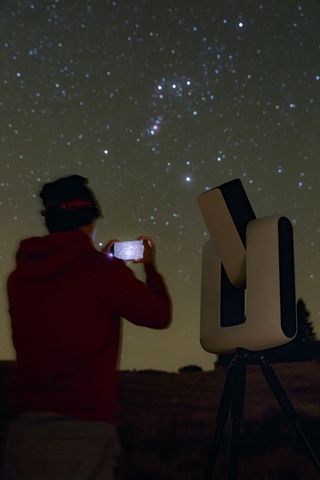This Smart Telescope for Newbies Looks Like a Sci-Fi Space Robot

NEW YORK — The makers of a new fully automated, motorized, app-enabled telescope say the smart device makes stargazing and astrophotography easier than ever and takes the hassle out of setting up and operating a telescope, so that you can just kick back and enjoy the view.
So, naturally, here at Space.com, we couldn't wait to check it out and see if it lived up to the claims. We had a chance to see the smart telescope, called Stellina, here at the Museum of Modern Art (MoMA), where the telescope will go on sale on May 10. Designed and built by the French company Vaonis, Stellina looks nothing like any telescope we've seen before.
The sleek, compact and rectangular body is about the size of a backpack and could easily pass for some kind of sci-fi space robot. There's no eyepiece on it; instead of peering directly into the telescope, the user conducts astronomical observations from the screen of a smartphone or tablet. Cyril Dupuy, CEO of Vaonis, gave us a demo of this futuristic stargazing machine.
Related: Best Telescopes for Beginners
Perhaps the most exciting thing about Stellina is that it requires almost no setup. With other auto-guided telescopes, calibrating and aligning the equipment can be a long and tedious process. The telescopes I used in my college astronomy class took about 45 minutes to get up and running. Stellina is smart enough to calibrate itself, so all you have to do is attach the tripod, turn it on and load the app — and you're ready to go! Just use the mobile app to select a target in the sky, and Stellina will automatically locate it and display the object on your screen.
Another feature that stands out is Stellina's catalog and search function. While other telescopes will have you scrolling through long lists of objects on a tiny display, you can search Stellina's catalog by typing in the name of whatever object you're trying to find. Stellina's catalog also includes gorgeous images for each entry. This makes for a much more pleasant user experience — but it could also eat up your mobile data if you aren't connected to a Wi-Fi network.
During the demo, Dupuy selected a beautiful spiral galaxy, and with the touch of a finger, the telescope automatically steered its lens toward that galaxy's location in the sky.
Get the Space.com Newsletter
Breaking space news, the latest updates on rocket launches, skywatching events and more!
Stellina can capture images and videos of deep-space objects like galaxies, nebulas and star clusters, but it's also a great tool for looking at the moon, watching eclipses, and even tracking comets and asteroids in our solar system.
It provides a simple way to do astrophotography, but professional astrophotographers should note that this telescope has an altitude-azimuth mount, which isn't ideal for long-exposure shots. For serious astrophotography, equatorial mounts are "virtually mandatory," as they are better at compensating for Earth's rotation, according to Sky & Telescope. However, Stellina does have a built-in field derotator that allows the camera to capture exposures of up to 5 minutes.
Another downside is that the telescope depends on wireless networks and GPS, so it's probably not ideal for stargazing adventures in rural areas where your phone can't get a signal.
On the bright side, the telescope has a built-in light-pollution filter, which is helpful for skywatchers in light-polluted areas like cities and suburbs. You can also add a solar filter to observe sunspots and solar eclipses.
While this telescope is perfect for beginners, it also comes with a hefty price tag of $2,999. You can find out more about the telescope's specs and preorder it at Vaonis.com. It goes on sale May 10 exclusively at the MoMA Design Store (both online and at the store's SoHo and Midtown locations in New York City).
Editor's note: This article was updated to reflect that Stellina is no longer available at the discounted price of $2,499 from Vaonis.com. It has also been updated to clarify that Stellina's camera can capture up to 5-minute-long exposures.
Email Hanneke Weitering at hweitering@space.com or follow her @hannekescience. Follow us @Spacedotcom, Facebook and Google+. Original article on Space.com.
Join our Space Forums to keep talking space on the latest missions, night sky and more! And if you have a news tip, correction or comment, let us know at: community@space.com.

Hanneke Weitering is a multimedia journalist in the Pacific Northwest reporting on the future of aviation at FutureFlight.aero and Aviation International News and was previously the Editor for Spaceflight and Astronomy news here at Space.com. As an editor with over 10 years of experience in science journalism she has previously written for Scholastic Classroom Magazines, MedPage Today and The Joint Institute for Computational Sciences at Oak Ridge National Laboratory. After studying physics at the University of Tennessee in her hometown of Knoxville, she earned her graduate degree in Science, Health and Environmental Reporting (SHERP) from New York University. Hanneke joined the Space.com team in 2016 as a staff writer and producer, covering topics including spaceflight and astronomy. She currently lives in Seattle, home of the Space Needle, with her cat and two snakes. In her spare time, Hanneke enjoys exploring the Rocky Mountains, basking in nature and looking for dark skies to gaze at the cosmos.
